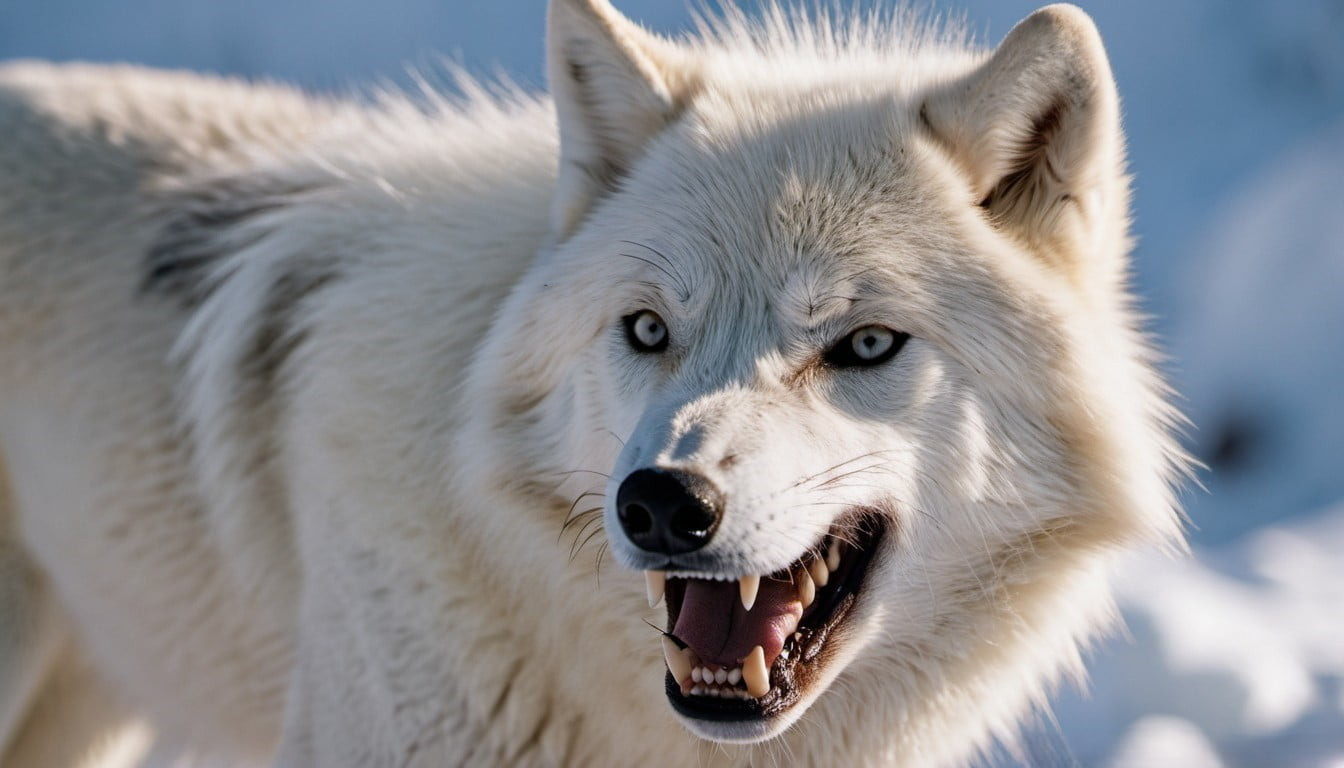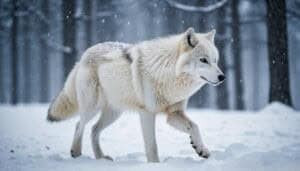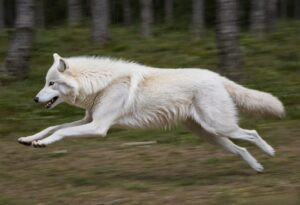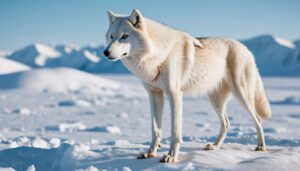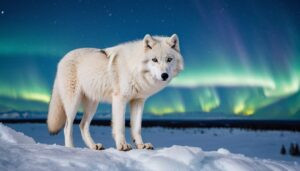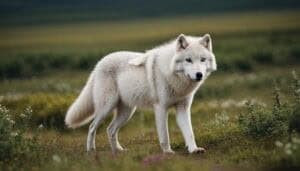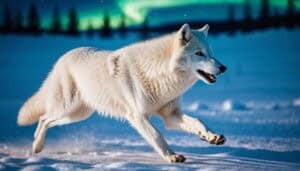Introduction
The Arctic wolf’s skeletal structure is a marvel of evolution, perfectly adapted to its predatory lifestyle and the harsh environment of the Arctic. This article explores the key features of the Arctic wolf’s skeleton, examining how the skull, teeth, spine, limbs, and joints work together to support hunting and survival
We’ll compare the Arctic wolf’s skeletal structure with other wolf species, discuss evolutionary adaptations, and look at how these bones enable stamina and endurance in extreme cold
Additionally, we’ll delve into the role of the skeletal structure in pack hunting strategies and the differences between male and female wolves
Key Features of the Arctic Wolf’s Skeletal Structure
Overview of Skeletal Structure
The Arctic wolf, a subspecies of the gray wolf, has a skeletal structure that is both robust and highly specialized for its predatory lifestyle in the Arctic
The skeleton is composed of approximately 320 bones, including the skull, vertebral column, ribs, and limbs, all working together to support the wolf’s movements, hunting abilities, and survival in extreme conditions
Important Bones and Joints
Key components of the Arctic wolf’s skeletal structure include:
Skull: The skull is large and robust, housing powerful jaws and sharp teeth
Vertebral Column: Comprising the cervical, thoracic, lumbar, sacral, and caudal vertebrae, the spine provides both flexibility and strength
Ribs and Sternum: These protect vital organs and support the muscular system
Limbs: The forelimbs and hindlimbs are built for endurance and speed, crucial for chasing prey
Joints: Highly flexible joints, particularly in the shoulders and hips, allow for a wide range of movement essential for hunting
Predatory Adaptations in the Skull, Teeth, and Spine
Skull Shape and Strength
The Arctic wolf’s skull is a critical element of its predatory toolkit. It is designed to be both strong and lightweight, allowing for a powerful bite without unnecessary weight. The broad and elongated shape provides a large surface area for muscle attachment, enhancing jaw strength
The zygomatic arches are particularly pronounced, supporting the strong masseter muscles that drive the wolf’s powerful bite
Teeth Structure and Function
The dental formula of the Arctic wolf includes incisors, canines, premolars, and molars, each adapted for specific functions in predation:
Incisors: Used for nipping and cutting flesh
Canines: Long and sharp, these teeth are designed for puncturing and gripping prey
Premolars and Molars: Equipped with carnassial teeth, these are adapted for shearing flesh and crushing bones
These dental adaptations enable the Arctic wolf to efficiently kill and process its prey, breaking down tough meat and bones with ease
Flexibility and Strength of the Spine
The spine of the Arctic wolf is both flexible and strong, supporting agile movements and high-speed chases. The cervical vertebrae allow for a wide range of head motion, crucial for scanning the environment and targeting prey
The thoracic and lumbar vertebrae provide the strength needed for powerful running and pouncing, while the sacral vertebrae stabilize the pelvis. The caudal vertebrae in the tail help with balance and steering during fast pursuits
Role of Spine in Hunting and Mobility
The combination of strength and flexibility in the spine is vital for the Arctic wolf’s hunting strategy. The vertebral column supports sudden bursts of speed and quick directional changes, enabling the wolf to chase down agile prey over rough and icy terrain
The intervertebral discs act as shock absorbers, cushioning the impact during high-speed runs and jumps, thus preventing injury and maintaining mobility
Limbs, Joints, and Their Role in Hunting
Limb Structure and Muscles
The limbs of the Arctic wolf are long and muscular, designed for both endurance and agility. The forelimbs are slightly shorter and more robust, supporting digging and grappling with prey
The hindlimbs are longer and more powerful, providing the necessary propulsion for running and jumping. Strong muscles, particularly in the thighs and shoulders, drive these movements
Joint Functionality and Movement
The joints in the Arctic wolf’s limbs are highly flexible, allowing for a wide range of motion. The shoulder and hip joints are particularly important, as they enable the wolf to extend its legs fully during a sprint and retract them for powerful jumps
The joints are stabilized by ligaments and tendons, which provide both support and flexibility. This combination allows the Arctic wolf to move swiftly and precisely, adapting to the unpredictable movements of its prey
Comparative Analysis and Evolutionary Adaptations
Differences in Skeletal Structure with Other Wolf Species
While the Arctic wolf shares many skeletal features with other wolf species, it has several unique adaptations. Compared to the gray wolf, the Arctic wolf has a more compact body, shorter legs, and denser bones, adaptations that help conserve heat and support survival in the frigid Arctic climate
These differences impact behavior and hunting strategies, with the Arctic wolf being more adapted to long-distance travel over ice and snow
Historical Evolution of the Skeleton
Over time, the Arctic wolf’s skeleton has evolved to meet the demands of its environment. Natural selection has favored wolves with stronger, denser bones and more efficient energy use
These evolutionary changes have resulted in a skeletal structure that supports endurance hunting, allowing the Arctic wolf to travel long distances in search of prey and survive in a habitat with sparse food resources
Adaptations to Changing Environments
As the Arctic environment continues to change, so too does the Arctic wolf’s skeletal structure. Recent studies suggest that these wolves may be developing even greater bone density and muscle mass to cope with the increasingly harsh conditions and the shifting availability of prey
These adaptations ensure that the Arctic wolf remains a top predator, capable of thriving despite environmental challenges
Skeletal Adaptations for Endurance and Extreme Cold
Bone Density and Strength
The Arctic wolf’s skeletal structure has evolved to exhibit increased bone density and strength, essential for its survival in the extreme conditions of the Arctic
This increased density not only supports the wolf’s muscular frame but also aids in conserving body heat, a critical factor in the frigid Arctic climate. Denser bones provide a sturdy foundation that can withstand the physical demands of hunting large prey and traversing rugged, icy terrain
Skeletal Insulation Mechanisms
In addition to bone density, the Arctic wolf’s skeletal structure includes specific adaptations that help with insulation. The bone marrow, which produces red and white blood cells, also plays a role in maintaining body temperature. The compact nature of the bones reduces the amount of exposed surface area, thereby minimizing heat loss
Furthermore, the fatty deposits surrounding the bones provide additional insulation, helping the wolf to retain warmth during long periods of cold exposure
Skeletal Support for Long-Distance Travel
Endurance is a key survival trait for the Arctic wolf, and its skeletal structure is optimized for long-distance travel. The limb bones are elongated and robust, allowing the wolf to cover great distances without expending excessive energy
The metacarpal and metatarsal bones in the paws are particularly well-developed, providing a broad base that supports efficient movement across snow and ice. This skeletal design enables the Arctic wolf to follow migrating herds of prey and explore vast territories in search of food
Energy Efficiency in Movement
The Arctic wolf’s skeletal structure is not only built for strength and endurance but also for energy efficiency. The joints, particularly in the limbs and spine, are designed to maximize movement with minimal effort. The ball-and-socket joints in the shoulders and hips allow for a wide range of motion, while the hinge joints in the knees and elbows enable powerful strides
This efficient movement is crucial for conserving energy during long hunts and extended travel across the Arctic tundra
Pack Hunting and Sexual Dimorphism in Skeletal Structures
Coordination and Movement in Packs
Arctic wolves are highly social animals that hunt in packs, and their skeletal structure supports this cooperative behavior. The vertebral column and limb joints are flexible enough to allow for synchronized movements, essential for coordinated pack hunting strategies
The ability to move swiftly and precisely as a unit increases the pack’s success rate in capturing prey. The skeletal structure also supports vocal communication, with the hyoid bone in the throat enabling a range of howls and barks that help wolves coordinate during hunts
Skeletal Features Enhancing Team Hunts
Certain skeletal features are particularly advantageous for team hunting. The robust skull and powerful jaws enable wolves to quickly incapacitate their prey, while the strong limbs and flexible spine allow for agile movements that are crucial during a chase
The ability to sustain high-speed pursuits over long distances is a key factor in the Arctic wolf’s hunting success. Additionally, the strong, padded paws provide traction on icy surfaces, further enhancing the wolves’ ability to work together during hunts
Differences Between Males and Females
Sexual dimorphism, the physical differences between males and females, is evident in the skeletal structures of Arctic wolves. Male wolves typically have larger, more robust bones and greater muscle attachment sites, reflecting their role in taking down larger prey and defending the pack
Female wolves, while generally smaller, possess a more streamlined skeletal structure that aids in the efficient rearing and protection of pups. These differences contribute to the overall success and survival of the pack, as each gender brings unique strengths to their cooperative efforts
Impact on Behavior and Roles in Packs
The differences in skeletal structure between male and female Arctic wolves influence their behavior and roles within the pack. Males often take on leadership and protective roles, utilizing their greater strength and size
Females, with their slightly more agile frames, are vital for nurturing and defending the young, as well as participating in hunts. This division of labor, supported by their skeletal adaptations, ensures the pack’s cohesion and efficiency in both hunting and survival tasks
Conclusion
The Arctic wolf’s skeletal structure is a remarkable adaptation that supports its predatory lifestyle and survival in one of the harshest environments on Earth. Key features of its skeleton, including a robust skull, sharp teeth, flexible spine, and strong limbs, all contribute to its hunting prowess and agility. These adaptations are essential for capturing prey and enduring the extreme cold of the Arctic
The skull and teeth of the Arctic wolf are specialized for powerful bites and efficient processing of flesh and bones. The spine provides the flexibility and strength necessary for rapid, agile movements during hunts, while the limbs and joints support endurance and precise coordination within the pack. Comparative analysis with other wolf species highlights unique skeletal adaptations that enable the Arctic wolf to thrive in its environment
Evolutionary changes have further optimized the Arctic wolf’s skeletal structure for survival, with increased bone density and insulation mechanisms that conserve heat. The ability to travel long distances efficiently is crucial for following prey and exploring vast territories
Additionally, sexual dimorphism in skeletal structures reflects the division of labor within the pack, with males and females contributing unique strengths to their cooperative efforts
Overall, the Arctic wolf’s skeletal structure is a testament to the power of natural selection, providing the necessary tools for hunting, endurance, and survival in the Arctic. These adaptations ensure that the Arctic wolf remains a top predator, capable of thriving in an ever-changing and challenging environment
